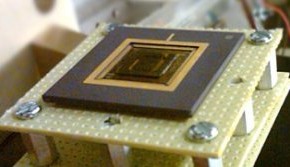New MEMS Device Generates More Energy From Small Vibrations
on

Researchers at MIT have designed a novel device the size of a U.S. quarter that harvests energy from low-frequency vibrations, such as those that might be felt along a pipeline or bridge. The tiny energy harvester — known technically as a microelectromechanical system, or MEMS — picks up a wider range of vibrations than current designs, and is able to generate 100 times the power of devices of similar size.
To harvest electricity from environmental vibrations, researchers have typically looked to piezoelectric materials, or PZT, such as quartz and other crystals. Various designs are based on a small microchip with layers of PZT glued to the top of a tiny cantilever beam. As the chip is exposed to vibrations, the beam moves up and down like a wobbly diving board, bending and stressing the PZT layers. The stressed material builds up an electric charge, which can be picked up by arrays of tiny electrodes. However, the beam itself has a resonant frequency and outside of this frequency, the beam’s response drops off, along with the amount of power that can be generated.
The researchers at MIT came up with a new design that increases the device’s frequency range while maximizing the power density. The team engineered a microchip with a small bridge-like structure that’s anchored to the chip at both ends with a single layer of PZT deposited to the bridge, placing a small weight in the middle of it. This design was found to respond to a wide range of low frequencies. The researchers calculated that the device was able to generate 45 microwatts of power with just a single layer of PZT — an improvement of two orders of magnitude compared to current designs.


Discussion (0 comments)